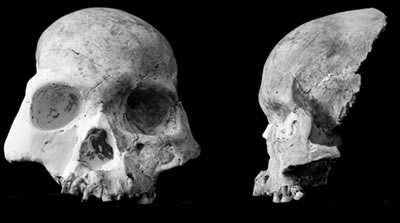The Red Deer Cave People are a recently-discovered population of unusual prehistoric humans who lived in southwest China approximately 11,500-14,500 years ago. Miners unearthed the fossils while quarrying limestone in Maludong Cave in 1989. The site later took on the name Red Deer Cave, due to the large number of red deer bones found there. Scientists stored the human remains until a team of researchers began to study them in 2008.
The fossils exhibit a unique combination of both primitive and modern features. While scientists initially believed the remains represented an archaic species, radiocarbon dating of charcoal from contemporaneous layers of the cave revealed that the individuals lived less than 15,000 years ago, indicating that they overlapped in time with anatomically modern humans for several thousand years.
While similar to the remarkable discovery of Homo floresiensis in 2003, the individuals found at Red Deer Cave have an entirely different combination of mismatched features, including a prominent brow and cheekbones; a low, rounded braincase and flat face; thick skull bones; very large molars; protruding jaws; and a flat, unpointed chin. At an estimated weight of 110 pounds (50 kilograms), they were also much smaller than modern humans.

However, the thigh bone has been of particular interest, as it lacks the head that fits into the hip socket in modern humans. The bone’s unusual shape suggests that the individuals walked more like early Homo erectus and Homo habilis than modern humans.
Due to their unusual characteristics, some anthropologists have proposed the Red Deer Cave People as a new species of human. They speculate that the individuals could either represent a very early modern human population that settled the area more than 100,000 years ago and became isolated, or a late-surviving archaic species. Others believe they may be hybrid descendants of modern and ancient humans. However, some anthropologists contend that the Red Deer Cave People simply reflect modern human diversity. While DNA analysis could shed light on their origins, attempts to obtain DNA from the fossils have so far proven unsuccessful.